Growing Up in Scotland: Sweep 3 Food and Activity Report
This report uses data from the Growing Up in Scotland study to explore the prevalence of, and many issues related to, food and activity in Scotland specifically in relation to young children.
Chapter 2
Diet and eating
2.1 Introduction
Improving the eating habits and nutrition of children remains a key policy priority as part of the Scottish Government's wider strategic objective for a healthier Scotland. The challenge facing policy makers remains considerable in the context of rising levels of childhood overweight and obesity and socio-economic health inequalities. Data from the Scottish Health Survey indicated that in 2003 almost a third (32%) of children aged 2-15 had a Body Mass Index outside a healthy range, with the prevalence of obesity running at 18% of boys and 14% of girls (Scottish Executive, 2005). In 2006 a review of the Scottish Diet Action Plan concluded that overall dietary patterns were moving in the opposite direction to the Scottish Dietary Targets introduced in 1996 (Food Standards Agency, 2006). In particular, consumption of added sugars has increased, with children in Scotland now eating almost double the recommended level (17% of total food energy compared to the Scottish Dietary Target of 10%) (Food Standards Agency, 2008).
Whilst school based health interventions such as Hungry for Success have made substantial progress in promoting healthy eating and food provision in schools, there is growing evidence of the importance of positive changes in diet in early pre-school childhood in bringing about a lasting impact on health and well being in adult life. As discussed in section 1.1, the Scottish Government has recently devoted £56 million over the next 3 years to tackle the joint problems of diet, physical activity and obesity in Scotland. A substantial amount of this funding will be directed towards improving nutrition in the early years, with the specific aim of supporting parents and children outside of school to achieve the necessary step change in children's dietary habits across all sectors of the population, particularly among disadvantaged sections of society. This includes child healthy weight interventions as well as increasing access to healthier food choices for low income families, and providing the education and skills to allow people 'to break through barriers of food affordability and availability and the negative impact of culture and lack of food skills' (Scottish Government, 2008b). Understanding the factors that influence what food parents choose to provide for their children is essential if such interventions to support healthy eating are to be effective.
Although more limited in scope than dedicated diet and nutrition studies, GUS is nevertheless able to provide useful information on the range of food types - both healthy and unhealthy - eaten by pre-school children on a typical day. Moreover, the study has the additional benefit of including a suite of questions designed to examine parental views and experiences in relation to their children's eating. In combination, these allow for the exploration of choice, behaviour and experiences in early years provision and consumption of food across socio-economic groups. Results shown in this chapter focus on data collected from the child cohort at sweep 3 of the survey when the children in the child cohort were aged just under 5 years old.
2.2 Eating habits
2.2.1 Fruit and vegetables
Doubling the average intake of fruit and vegetables per day remains a key objective of the Scottish Dietary Targets for children. The 'five-a-day' message of public information campaigns has played a key role in promoting healthier food choices as part of the wider drive to achieve dietary change across all sectors of Scottish society. 1 Overall, the consumption of fruit and vegetables by children in the survey was encouragingly high:
- Almost all children (96%) ate at least one type of fruit a day, with 60% having two or three types a day and 24% eating four or more.
- Over half (52%) of children ate two or three types of vegetables a day and 7% ate four or more.
- However, 27% of children ate only one type of vegetables and 14% ate none in a typical day.
2.3 Sugary snacks and drinks
Parents were also asked about their child's consumption of less healthy foodstuffs such as sweets, chocolates, crisps and non-diet soft drinks. 2 Recent evidence suggests that children in Scotland get most of their sugar intake from these types of unhealthy foods (Food Standards Agency, 2008). Overall, regular consumption of unhealthy sugary and salty food was high:
- Almost half of all children (49%) ate sweets or chocolates once a day or more,
and 43% drank non-diet soft drinks. - Crisps or savoury snacks were slightly less popular - a quarter (25%) of children in the survey ate crisps once a day or more.
2.3.1 Socio-economic differences in diet
It is well established that disadvantaged groups in society are more likely to eat less fruit and vegetables and more unhealthy foods than others. These patterns of inequality are clearly reflected when the diet of children in the survey is examined in relation to the socio-economic position of their mother.
- Twenty-seven percent of children whose mother had Higher grades or above ate four or more types of fruit per day, compared to 12% of children whose mother had no qualifications.
- Children in semi-routine and routine households, in the lowest income group and
in deprived areas were much less likely to eat four or more types of fruit per day. - Forty-two percent of children from semi-routine or routine households ate crisps
or savoury snacks once a day or more, compared to only 17% of children from managerial or professional backgrounds. - Well over half (56%) of children from low income households drank non-diet soft drinks once a day or more, in contrast to only 30% of children from households in the highest income bracket.
- Over a third (34%) of children from households in the most deprived areas ate crisps and savoury snacks compared to 13% of children from the most affluent areas.
2.4 Diet scale
In order to build up more of a relative picture of children's overall diets in GUS, the information on children's consumption of different foods was used to produce a diet scale. The scale is based on five questions regarding children's diet:
- How many different types of fresh/frozen/tinned vegetables does the child eat
on a typical day? - How many different types of fresh/frozen/tinned/dried fruit does the child eat on a typical day?
- How often does the child usually eat crisps?
- How often does the child usually eat chocolates or sweets?
- How often does the child usually drink non-diet soft drinks?
The dietary scale had a range of 5 to 31. A low score indicates that a child eats a small variety or no vegetables or fruit, but consumes crisps, sweets and soft drinks often. A high score indicates that a child eats a large variety of fruits and vegetables, and hardly ever consumes crisps, sweets and soft drinks. A child would therefore have a score of 5 if they never ate fruit or vegetables but consumed crisps, chocolate and sweets and
soft-drinks more than once a day. The average score for all toddlers was 17 with a minimum of 5 and a maximum of 31. The diet scale was divided into 'poor', 'average' and 'good' diet categories, for children who had a low, average and high score. It is important to remember that due to the nature of the score, the terms poor, average and good diet are relative terms which refer to the overall eating patterns of all the children taking part in GUS and not an objective assesment of the quality of children's diets.
Table 2.1 Descriptive results on dietary scale
N |
Minimum |
Maximum |
Mean |
Std. Deviation |
|
|---|---|---|---|---|---|
Diet score |
2329 |
5.00 |
31.00 |
17.2 |
4.6 |
As would be expected, similar socio-economic patterns to those within specific foods and variety of foods eaten, could be seen in relation to the diet score. In particular:
- Fifteen percent of children in managerial and professional households were classified as having a relatively poor diet, in contrast to 34% of children in Semi-routine and routine households.
- Thirteen percent of children in the highest income group were also in the poorest diet group, in contrast to 39% of those in the lowest income group.
- Nineteen percent of children of mothers with Higher Grades or above had a poor diet, compared with 40% of children whose mothers had no qualifications.
These findings illustrate the considerable socio-economic gap in eating habits between different groups of people in Scotland. The question remains why it is those children from households in deprived areas, and with mothers on low incomes and with least education that are least likely to meet government targets on healthy eating and nutrition. GUS included a number of questions asking respondents about a range of issues and the extent to which they influence what children eat.
2.5 What influences parental food choices?
2.5.1 A knowledge gap?
One possible explanation for finding a significant socio-economic distinction in eating habits is that it represents a gap in knowledge, i.e. that the healthy eating message is simply not being heard in those communities most at risk, or that certain groups are unable to act upon it due to a lack of necessary food skills. GUS included several measures to explore this theory in more depth.
The first measure asked respondents how much their knowledge of cooking influenced what they gave their children to eat. Over one in ten (13%) said this affected what they gave their child 'a lot'. However, on closer inspection this appears to have been a largely positive effect, due to the respondent knowing a lot about cooking (78%) rather than lacking knowledge (22%).
The second measure asked parents to rate how much they knew about healthy eating, on a scale from 'nothing' to 'quite a lot'. Encouragingly, the vast majority of mothers said they knew either a great deal (38%) or quite a lot (58%) about healthy eating, with only 4% saying they knew not very much or nothing. Those who knew a lot about healthy eating were also far more likely to say their child ate four or more types of fruit a day (27% compared to 8% of those who knew not very much). However, those mothers on low incomes and from deprived areas were much less likely to report knowing 'a great deal' about healthy eating. Half of mothers in the highest income bracket knew 'a great deal' about healthy eating, compared to less than a third (30%) in the lowest income bracket (Figure 2 A).
Figure 2 A Knows 'a great deal' about healthy eating, by annual household income and area deprivation
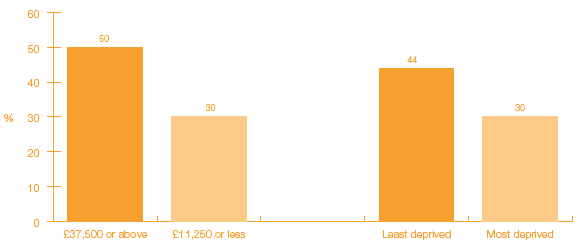
Base: All child cohort: weighted - 2332, unweighted - 2280.
2.5.2 A lack of control?
Those mothers who were teenagers at the time their child was born and those with no qualifications were also much less likely to know 'a great deal' about healthy eating. Only 22% of mothers who were aged under 20 at the time of their child's birth knew 'a great deal' about healthy eating, compared to 58% of those who were aged 40 or older. It would seem that, to a certain extent, the healthy eating message is not getting through to some groups as much as might be hoped, suggesting that a different approach may be needed to raise awareness in those groups of the population identified as most at risk.
Level of knowledge of healthy eating, however, is not necessarily the key determinant of what food parents provide their children. As Figure 2 B demonstrates there was a clear drop in those consuming sweets, crisps and soft drinks once a day or more between those who knew not very much or nothing about healthy eating and those who knew a great deal (72% to 45% for sweets and chocolates for example). It is striking that even in those households where the mother knew 'a great deal' about healthy eating, almost half (45%) of children ate sweets once a day or more and 38% drank soft drinks.
Figure 2 B Daily consumption of unhealthy foods by knowledge of healthy eating
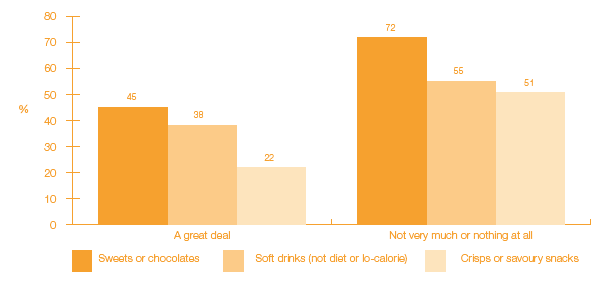
Base: All child cohort: weighted - 2332, unweighted - 2280.
There is evidence to suggest that many parents feel unable to fully control what their child eats, particularly when it comes to unhealthy snacks. When asked how easy or difficult it was to control the amount of sweets, sugary snacks and drinks their child eats or drinks, a significant minority of mothers (16%) said they found it fairly or very difficult. By far the most common reason, mentioned by 66% of those who had difficulty, was grandparents 'spoiling' children by giving them sweets and sugary snacks. A further third (33%) mentioned that other relatives made it difficult to control their child's unhealthy snacking. External influences therefore play a part in shaping the diet of pre-school children, with parents feeling unable to fully control the amount of unhealthy food their child eats.
Parents also reported that often the child's willingness or otherwise to eat certain types of food also had a notable impact, with 12% saying this affected what they gave their child 'a lot' (Figure 2 C). Around a third (34%) also had difficulty controlling their child's unhealthy snacking due to the child wanting what they saw in a shop, whilst another 27% wanted what other children had.
Figure 2 C Factors influencing what children eat
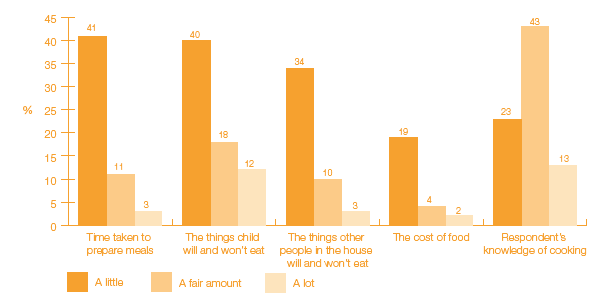
Base: All child cohort: weighted - 2332, unweighted - 2280.
2.5.3 The cost of food?
On initial glance it might appear that the cost of food does not have much impact on what food parents provide for their child (Figure 2 C). However, it is worth noting that the cost of food had some effect for 41% of the lowest income group and 34% of those in deprived areas, compared to only 11% of those in the top income group and 19% of those in the least deprived areas.
There is some argument over whether the cost of healthy food might prohibit those in lower income groups and deprived areas from making healthier food choices given the common perception that healthier foods are often more expensive. Indeed, a recent report by the National Consumer Council criticised several leading supermarkets for cut price promotions of cheap sugary and fatty foods. The report found that 54% of promotions on related to foods high in fat and sugar, despite Food Standard Agency ( FSA) advice that these make up only 7% of our diet. Only one in eight promotions featured fruit and vegetables (Yates, 2008). It therefore seems likely that cost, or at least perceptions of cost, is a major factor in the choice between the provision of healthy and unhealthy foods for many parents in low income and deprived households.
However examination of the types of meals eaten by children in the last week suggests that again, cost is just one factor affecting the provision of food for children. While almost all children (97%) had a meal prepared with fresh ingredients in the last week, a further 32% had a takeaway meal and 26% ate a fast food meal such as McDonald's. Unsurprisingly, given its low cost, easy availability and convenience, children in deprived areas and on low incomes were most likely to have eaten a fast food meal in the past week. Almost twice as many (36%) children in the most deprived areas had done so, compared to only 20% of children in the least deprived areas.
Perhaps more surprising is the proportion of children from deprived, low income and semi routine or routine households who ate a takeaway, such as that from a fish and chip shop or an Indian or Chinese meal, in the last week. Four in ten (41%) children in the most deprived areas had eaten a takeaway in the last week, compared to only 23% of children in affluent areas (Figure 2 D). Given the relatively high cost of takeaway meals it is interesting that those who are most likely to struggle financially and say that cost is an issue in what their children eat are also most likely to opt for this type of meal. Indeed, almost a third (32%) of children whose mothers said the price of food affected what they gave their child had eaten a takeaway meal in the last week. In similarity to other research, (Dobson
et al., 1994), GUS suggests that there is an additional cultural element affecting the type of food provided for children, possibly reflecting a reliance in low income households on prepared or convenience foods to fulfil the obligation to provide a family meal.
Figure 2 D Proportion of children having a takeaway meal in the past week by deprivation, income and NS-SEC
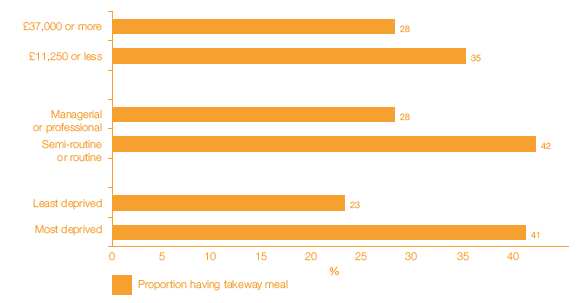
Base: All child cohort: weighted - 2332, unweighted - 2280.
Clearly there are a range of different social and economic factors affecting what food parents in different socio-economic groups provide for their children. GUS also introduced a series of questions exploring the structure and experience of mealtimes for these different groups in light of recent debate surrounding the potential erosion of family life, family meals and family time as a result of longer working hours for parents and changes in the size and make up of the average family unit. The next section explores the experiences of family mealtimes between different groups in Scotland.
2.6 How do eating experiences differ between socio-economic groups?
2.6.1 Where children eat
Overall, the majority of children (82%) 'mostly' ate their main meal at the same time as the rest of the family with just 5% only occasionally or never eating with the rest of the family. Whilst 62% of children ate in the kitchen or dining room, 32% ate in the living room. This varied considerably by a number of factors including age of mother at time of the child's birth, household income and area deprivation. Over two-thirds (67%) of children with a teenage mother at the time of their birth ate in the living room, compared to 24% of children with mothers over 40 at the time of the child's birth. Over half (53%) of children from households in the lowest income category ate in the living room, compared to just 13% of children in the highest income category. Children in the most deprived areas were over five times more likely to eat in the living room than those in the least deprived areas (57% and 11% respectively). These findings may of course reflect the size of property owned by different families, but they may also suggest a greater tendency towards less structured mealtimes in particular households.
2.6.2 The mealtime experience
Encouragingly, the majority of parents (52%) felt that mealtimes gave the family time to talk to each other and almost half (48%) said that mealtimes were mostly enjoyable (Figure 2 E). A third (33%) also said that mealtimes were 'never' rushed.
Figure 2 E Perceptions of mealtimes
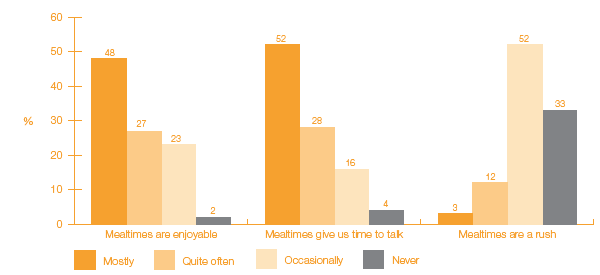
Base: All child cohort: weighted - 2332, unweighted - 2280.
However, as Figure 2 F and Figure 2 G demonstrate, there is again a socio-economic pattern in the likelihood of the family meal being enjoyable when the family has time to talk to each other. Whilst 55% of mothers in the least deprived areas said mealtimes were mostly enjoyable and 60% said the family mostly had time to talk, the corresponding figures for the most deprived areas were 36% and 38%. Younger mothers were also more likely to struggle with mealtimes - only 39% of teenage mothers found mealtimes enjoyable, compared to 60% of mothers aged 40 or older.
Figure 2 F Proportion saying mealtimes are 'mostly' enjoyable by maternal age, NS-SEC, income and deprivation
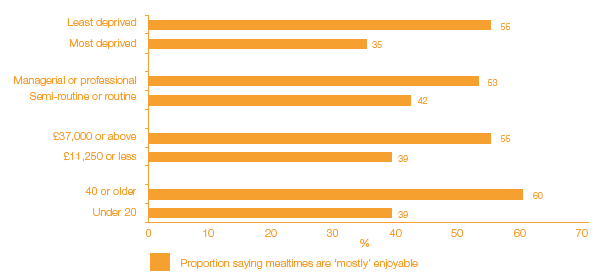
Base: All child cohort: weighted - 2332, unweighted - 2280.
The fragmentation of family life has at times been attributed to the growth of single parent households. Differences in attitudes to mealtimes were found between lone parent households and couple households, with mothers in lone parent households less likely to find mealtimes enjoyable and less likely to have time to talk. However, given that lone parents are more likely to be younger and on lower incomes, it is unclear which factor is most important in determining these responses.
Figure 2 G Proportion saying mealtimes 'mostly' give time to talk by NS-SEC, income and deprivation
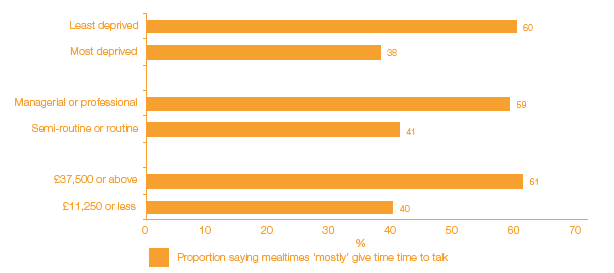
Base: All child cohort: weighted - 2332, unweighted - 2280.
The same groups who struggled to find meals enjoyable and to find time to talk were also those most likely to find mealtimes rushed. Twice as many parents in the highest income category said mealtimes were 'never' rushed (42% compared to only 20% in the lowest income group), with a similar pattern apparent between the least deprived and most deprived areas of Scotland.
2.7 Summary
It has long been recognised that a two-tier Scotland exists in terms of diet and nutrition, with those in deprived and low income households falling far behind the more affluent in terms of healthy eating and health outcomes. Children from low income and deprived households are consistently shown to eat less fruit and vegetables and more fatty and sugary foods than children more affluent households. However, there is little in-depth evidence exploring the complex reasons behind these discrepancies and the decisions that parents make in providing food for their children. These findings begin to build up a picture of the many factors that influence the provision of food in the early years. They point to a stark divide in food cultures between affluent households and those less well off, not just in what type of food is provided but also in parental views and experiences and the structure and character of mealtimes.
Understanding why people behave the way they do is essential if healthy eating policy interventions are to be effective and targeted at those who need them most. The myriad factors influencing the choice of food that parents provide - including cost, availability, convenience and culture - suggests that healthy eating public information campaigns and school initiatives can only go so far towards achieving dietary change across Scotland and, in particular, within those groups most at risk. More needs to be done to support parents and children in the early years, especially those from vulnerable sections of society, in making healthier food choices.
There is a problem
Thanks for your feedback